Brief

Foreword from Chief Executive Women
The Covid-19 pandemic has presented us with a unique, once-in-a-generation opportunity to redesign where and redefine how Australians work. As Australia embarks on the road to economic recovery, organisations across the country now have a significant opportunity to harness the full potential and talent of their workforce in how they reimagine the workplace. There is now an opportunity to strengthen workforce participation and productivity to build a more resilient, dynamic, and prosperous economy.
We know that the pandemic has had a disproportionate impact on women's workforce and economic participation. Women shouldered a higher increase in unpaid work in the household, limiting their engagement in paid work. Women were twice as likely as men to take on most of the unpaid domestic work, and more than three times as likely as men to take on caring responsibilities. Capitalising on levers that can unlock the untapped potential of women and enhance their contribution to workplaces and the economy will be key to rebuilding. The use of equitable flexibility is one of those levers.
While flexibility has in the past been seen as a ‘women’s issue’, we know now it can work for businesses, for the economy, and for all employees. And when implemented equitably, it creates equal opportunity for women and men to flourish and progress in the workplace. The Australian experience has demonstrated how flexibility at scale unlocks significant economic potential in the workplace. Organisations can optimise productivity and performance while tapping into a deeper talent pool. Many employees are reporting greater work-life balance and improved job satisfaction. As a result, and as our research with Bain & Company shows, employees want and expect to continue accessing flexible work options, including practices like flexible working hours, a condensed working week, job sharing, and working from home. Evidence suggests that organisations that have embraced equitable flexible work arrangements retain and attract the best talent.
Implementing flexibility at work demands purposeful leadership and action to design practices that are responsive to the needs of employees and work successfully for all stakeholders. Most importantly, it is critical to avoid and mitigate unintended consequences of flexibility. In order to ensure that flexibility delivers equally, careful consideration must be given to the ways in which flexibility may disadvantage those who access it.
Building on our previous research, ‘Flex for Success: Five Practices That Build a Flexible Workforce’, this report goes further in advancing equitable flexibility as a game changer for the Australian economy. This research draws on the diverse experiences of Australian companies during Covid-19 to provide an evidence base of best practices and insights for harnessing flexibility.
Ultimately, we call on organisations to embrace equitable flexibility that is:
- Practised at scale, rather than ad hoc;
- Encouraged without preconditions or judgement;
- Adopted by men and women at all levels of the company; and
- Without impediments to workplace participation, progression, learning/coaching, or effectiveness.
This means creating and promoting an inclusive culture that supports men and women to balance their aspirations in work and life, offering and promoting gender-equitable leave and working arrangements for all employees. Men and women need to have equal access to and uptake in working flexibly, without negative judgments or repercussions for career progression. Only when the playing field levels will all employees have equal opportunities to advance professionally.
If leaders and organisations are purposeful in how they build dynamic workplaces, we have the opportunity to realise the potential of our highly educated and talented workforce, and in turn maximise participation in and contribution to our economy. Companies have an opportunity to reset culture and accelerate expectations and policies surrounding flexible work. As we come out of the pandemic, how we choose to work will influence our productivity and performance as an economy.
Against the backdrop of a highly uncertain global economic environment, we need to draw on all the talent and investment in both women and men to reinvigorate our economy. This is our catalyst to create powerful, lasting change.
A joint effort from our business and civic leaders can deliver this vision of equitable flexibility and create a more prosperous economy—for everyone.
Sam Mostyn
President, Chief Executive Women
Introduction
The World Economic Forum (WEF) Global Gender Gap Index benchmarks global companies and their gender performance against four key dimensions: economic participation and opportunity, educational attainment, health and survival, and political empowerment. In the 2021 rankings, Australia slipped in every major dimension but one: the educational attainment of women.
Even though Australia ranks first globally for educational attainment, women’s economic participation and opportunity ranking continues to fall. Australia ranked 18th in economic participation and opportunity in 2011 but is 70th today. In 2011, Australia ranked 23rd on the Global Gender Gap Index overall but sits in 50th place today.
Domestically focused studies also find statistics underpinning those global rankings. In the 2020 Chief Executive Women (CEW) Census, 5% of ASX 200 companies had women CEOs, and women held only ~15% of the pipeline roles to CEO (i.e., line and CFO roles). In 2021, the Australian Bureau of Statistics found a 13.4% difference between men's and women’s average weekly earnings. When additional compensation is accounted for, such as superannuation and bonuses, the full-time total remuneration gender pay gap is 20.1%.
The numbers and their message are clear: Australia’s gender gap is widening. Urgent and critical change is needed to equalise gender participation and advancement in the workforce.
Conversely, the workforce critically needs women. The pandemic distressed businesses across Australia, and recovery requires all hands on deck—men and women. The pandemic unlocked a key lever that affects women’s participation in the workforce: flexibility.
Covid-19 fundamentally changed the way organisations operated. It challenged how companies viewed flexible work, because the need for flexibility affected every worker, regardless of rank, job role, or gender. The pandemic created urgency and accelerated critical changes surrounding flexible work. Now, crucial pieces are lining up to normalise flexibility.
As many organisations redefine what’s ‘normal’ in the workplace, this research can help companies understand—and plan for—what happens next. We surveyed employees and interviewed employers across Australia to understand their sentiments, perceptions, and desires pertaining to flexible work since the pandemic. Based on the findings, we offer fundamental questions for leaders and tactics to increase equitable flexibility. Our research also outlines a powerful economic argument: Unlocking purposefully designed flexibility is a strong economic imperative.
In our interviews, we learned how Australia’s top companies are leveraging Covid-19 as a ‘culture accelerator.’ If we all seize this opportunity, we can create more flexible, equitable, and resilient organisations, and a stronger, more prosperous economy.
How Covid-19 changed the workplace
Before 2020, large-scale flexible work was considered too difficult to achieve. The technology to support flexible work existed, but companies lacked the appetite to invest in the required infrastructure, processes, and cultural buy-in. Then, Covid-19 challenged ‘business as usual.’
Nearly overnight, to maintain continuity, companies restructured their workplaces. For a period of time, Australians were legally required to work from home unless it was impossible to do so. As a result, most workers—especially those with caring responsibilities—had to shift more than just their work sites. Many workers had to change schedules or temporarily step out of the workforce to accommodate increased caretaking responsibilities.
Since the pandemic, ‘flexibility’ and ‘working from home’ have become interchangeable, but our research goes beyond the typical discourse of remote work. We discuss an all-encompassing definition of flexibility, which includes variable start and finish times, condensed workweeks, and countless other arrangements.
Flexibility can be more informal than we realise. Sometimes it’s as simple as going to a doctor’s appointment in the middle of a workday without needing to ask for permission. For example, at Aurecon, workplace flexibility is not just for caretakers; its policies encompass equally important commitments to employee well-being, non-work commitments, and hobbies.
Through surveys and interviews, we confirmed:
- Flexible and remote-work arrangements can work at scale. Despite having to juggle other arrangements, over 90% of managers said they maintained or improved their productivity, engagement, and achievement while working from home during the pandemic compared with pre-Covid-19 times. In fact, Australia Post reports its Digital and Data team is twice as productive now than it was pre-Covid-19.
- The pandemic normalised work-life balance and equalised flexible work as an ‘all-employee’ issue versus a female-focused benefit. 80% of survey respondents believe flexibility is viewed more favourably now than it was before the pandemic, and that more leaders and company practices support flex work. Likewise, 63% of survey respondents said their company is more flexible post-Covid-19 than it was three years ago. At Stockland, leaders said, ‘the office has changed forever’ and that the home may have as well, with more men appreciating the demands of balancing home and work.
- Employees want more flexible work options to continue. 57% of women and 66% of men said they expect their workplace to become more flexible after the pandemic subsides. 95% of respondents indicated they would take a flexible arrangement in the next three years if offered by their organisation (see Figure 1).
- Flexibility can level the professional playing field. When all employees worked remotely during the pandemic, 57% of men and 43% of women said the workplace became more gender equitable. Women said family distractions at home were the biggest driver of inequality (a factor not noted as strongly by men), and may account for women’s lower perception of equality during the pandemic.
If offered, both men and women would take a flexible arrangement in the next three years

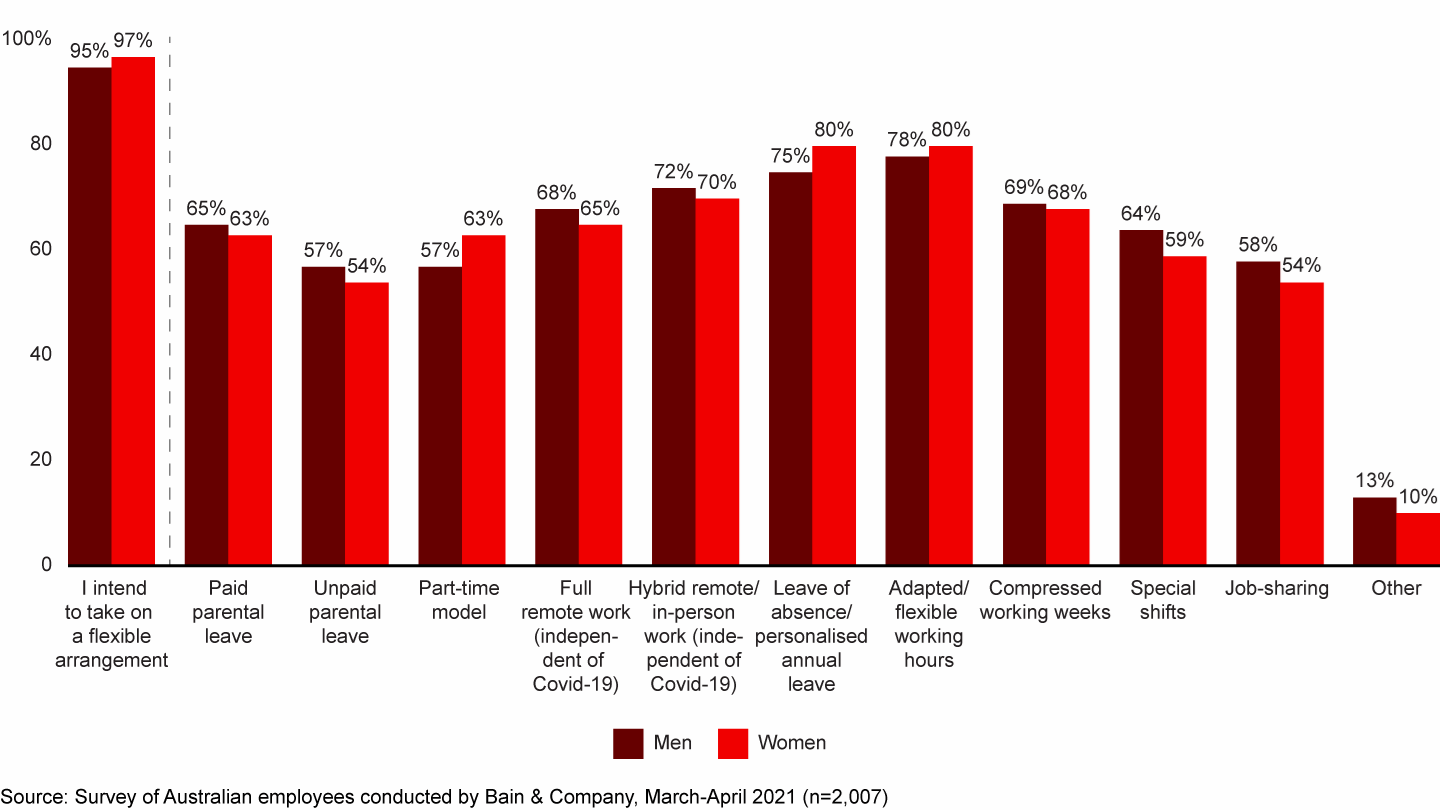
Flexibility is an economic and strategic imperative
In the future, flexibility will be a necessary feature of Australia’s employment landscape. Flexibility is not purely a well-being or sustainability initiative, nor a stopgap to bridge a crisis.
The Australian economy needs to embed flexibility as a key tenet of its post-Covid-19 strategy if it is to continue on a trajectory of strong growth. Similarly, companies need flexibility in their human capital strategies to enhance performance, remain relevant, and attract top talent.
The heart of these decisions—and the centre of public discourse—should be the strategic edge that flexibility can deliver.
Adopting flexible practices in aggregate encourages workforce participation among workers who would otherwise find it too costly to work or to invest in workplace skills. Our survey found that all flexible arrangements had an influence on workforce participation (see Figure 2).
All flexible arrangements influence workforce participation; having more options increases workforce participation

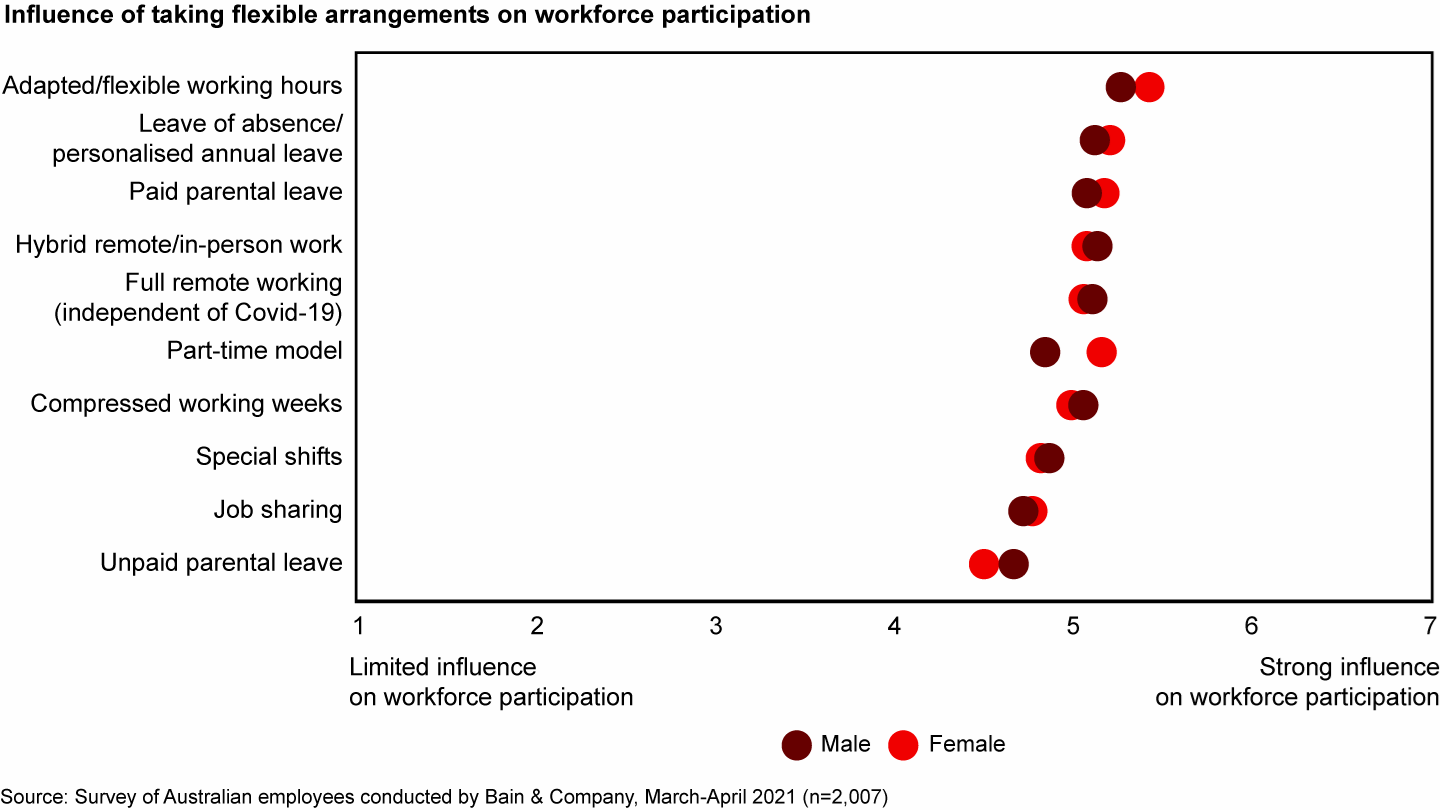
Specifically, women and minority groups are more likely to adopt flexible work, and more likely to participate in the workforce because of flexible options. Flexibility results in more people participating in the workforce overall, which creates more diverse cohorts. Diversity, in turn, boosts economic performance.
Taxpayers and society benefit from having productive individuals in the workforce because those workers are more likely to contribute in the form of taxes (and conversely, less likely to use the social safety net). Additionally, the World Economic Forum has consistently confirmed a correlation between gender equality, level of competitiveness, and GDP per capita. Several studies from the Organisation for Economic Co-operation and Development found reforms that make economies more flexible generally boost long-term economic prosperity.
The organisational lens is equally important. Flexibility offers a critical path toward gender diversity and equality in companies; higher female representation has proven causation to positive company performance. ASX-listed companies that increased the number of women on their boards by 10% or more gained nearly 5% in market value. For the average ASX-listed company, that equates to roughly $78.5 million.
Prior Bain & Company research has established a strong link between organic growth and a company’s employee Net Promoter Score℠ (eNPS) (i.e., the degree to which an employee would recommend the organisation to others): Inspired employees are three times more productive than dissatisfied workers. The most satisfied employees are 14 times less likely to leave than those who are the most disengaged. These factors boost financial performance; companies with the best human capital have growth rates three times faster than the S&P 500.
This survey found a strong correlation between employees’ assessment of their companies’ flexibility and their eNPS (see Figure 3). That is important because employees with a high eNPS are more productive and stay longer. Flexibility helps attract, retain, and inspire employees, and thereby, when leveraged equitably and at scale, has amplified returns.
Company flexibility is highly correlated to employee NPS

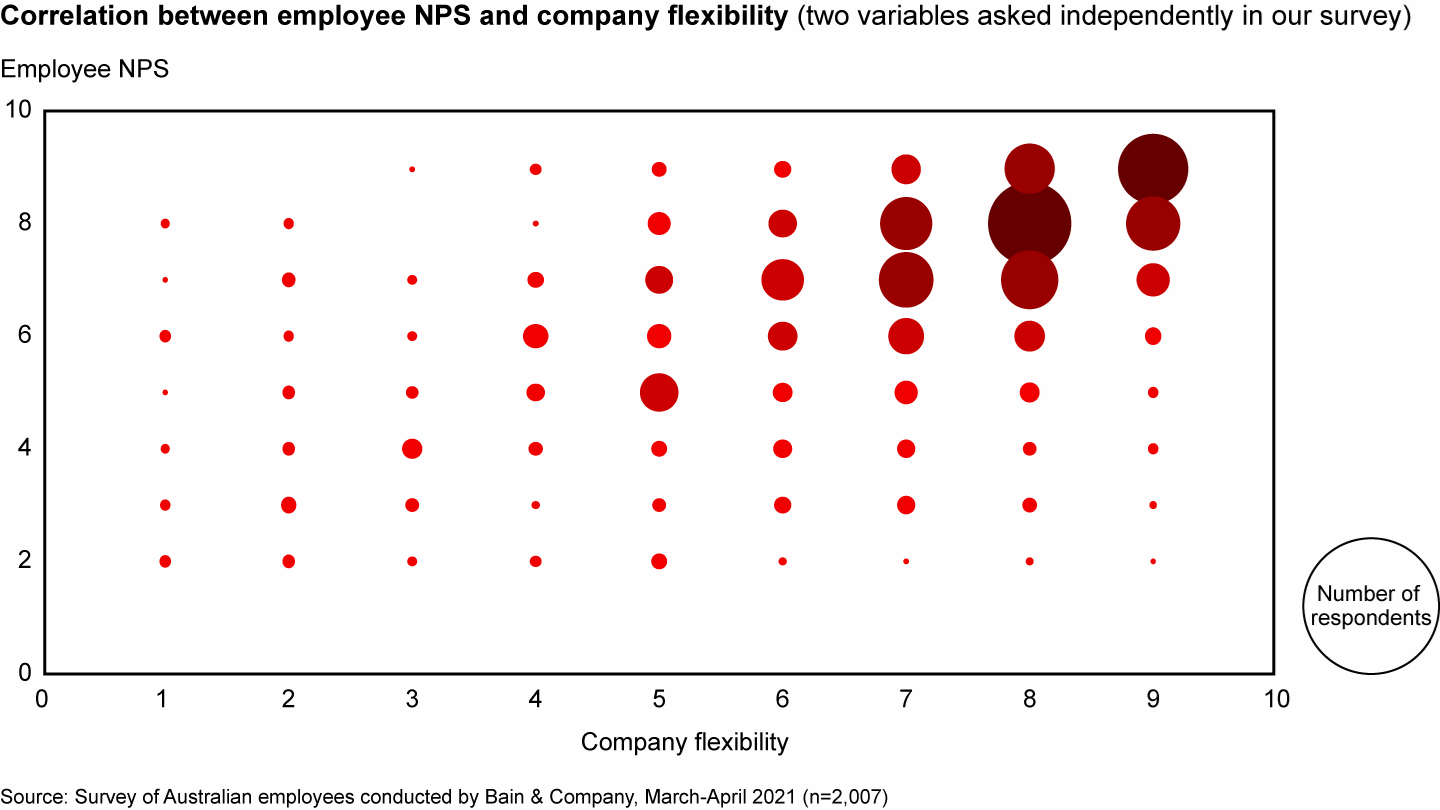
Through disruption, Covid-19 presented a unique opportunity. As we redefine ‘normal’ in the workplace, companies have an opportunity to reset culture and accelerate expectations and policies surrounding flexible work. As we rebuild, flexibility can enhance performance and bolster our economy.
Newmont has already found this to be true: Female attrition at the company decreased 35% over a 12-month period. Through numerous employee surveys, Newmont was able to directly link retention of women to an increase in remote-work options.
Flexibility can be a double-edged sword
Employees whose work is flexible report benefits such as better work-life balance, greater autonomy of schedule, and greater individual or organisational productivity/efficiency. Employees also said flexibility is the most effective way to overcome barriers to gender equality in the workplace, followed by unbiased recruitment, promotion practices, and leadership.
However, flexibility, if not thoughtfully planned, can have unintended adverse consequences. Employees view restrictions to career progression, longer work hours, and the need to be constantly accessible/‘on call’ as the biggest disadvantages of flexibility. There are also perceptual issues: Flexible workers are often perceived as being less committed to their roles and organisations. In an Australian Human Rights Commission report issued pre-Covid-19, 27% of men who worked flexibly said they experienced discrimination for being ‘less dedicated’ to their careers.
Those who work flexibly can be out of sight and out of mind, something one senior executive referred to as ‘death by a thousand cuts.’ Missing one hallway conversation does not matter, but missing those conversations time and time again adds up.
Flexible work, and especially remote work, can have different consequences based on an employee’s age or tenure in the workforce. Remote work may not fulfill the needs of junior staff who value culture, camaraderie, and on-the-job learning, which can be more challenging to replicate in disparate or asynchronous work environments. Gilbert + Tobin said its junior people can miss valuable on-the-job learning opportunities, such as getting pulled into last-minute client calls or partner meetings. They found that, at junior levels, an important component of learning comes from listening and observing more senior colleagues, in addition to ‘doing’ the work.
Likewise, Mirvac employee pulse checks identify three key benefits employees experience from working in the office: social interaction, collaboration to solve complex problems, and learning.
In Australia, women miss out on these opportunities the most. Women make up 67% of part-time workers and are nearly three times more likely to use a flexible working arrangement to manage caring responsibilities than their partners (80% compared to 28%).
Research from the Melbourne Institute affirms these findings and suggests that flexible work conditions could be a driving factor in career decisions for women but not men, and a key reason why gender disparity in the workforce is not narrowing. Unless flexible working arrangements like parental leave or part-time work are accessible to both men and women, such flexible policies could limit women’s accumulation of skills and experiences.
Hence the double-edged sword: Flexible work arrangements can keep women engaged in the workforce, which positively affects performance. However, if flexible work practices are not designed, offered, practised, or encouraged equally by men, they can intensify inequities in the workplace.
There are differences in equitable flexibility
Equitable flexibility can unlock the full potential of human capital, both male and female, and can become an essential tool for talent attraction, retention, and support. Creating equitable flexibility requires concerted and strategic effort.
To avoid adverse consequences, flexibility must be purposefully and carefully designed. This requires a clear definition of success; inclusion and integration of stakeholder and minority voices; empowering the right people to make decisions (e.g., those responsible for the team’s success); and incentivising simplicity and execution.
Further, equitable flexibility is:
- Practiced at scale, rather than ad-hoc;
- Encouraged without preconditions or judgement;
- Adopted by men and women at all levels of the company, especially senior men; and
- Without impediments to workplace participation, progression, learning/coaching or effectiveness.
Leveraging the momentum catalysed by Covid-19, we can accelerate women’s workforce participation and career progression through equitable flexibility. The pandemic presented a once-in-a-generation opportunity to redesign the workplace so it is more gender-equitable.
Whilst support for flex has improved, about 60% of employees surveyed think their companies could do more to encourage adoption. The case for equitable flexibility is clear. It is time for action.
Considerations and actions toward equity
To realise the benefits of equitable flexibility, employees should be encouraged to work however it suits them, and however it enables their wellbeing, the quality and timeliness of work meets individual and organisational standards and maintains or improves customer outcomes.
Since equitable flexibility is intentional and strategic (versus a crisis response), it must be sustainable for the longer term. Companies will need to continually balance multiple stakeholders’ needs (e.g., individual, team, company, and customer) and fine-tune arrangements to maximise performance.
These five questions will help leaders begin their organisation’s equitable flexibility journey:
-
Do we set clear definitions, company goals, and norms around flexibility, and do we collect data to track our performance against them?
-
Does our culture support the uptake of flexible work options by all groups?
-
Do we provide employees with the right technology and training to embrace flexibility?
-
Do we ensure employees have equal access and consideration for roles and opportunities?
-
Are leaders, particularly senior men, actively and authentically role-modelling flexibility?
To support leaders on their flexibility journey, we’ve developed an organisational assessment tool that you can use to see how well your organisation performs against these five key questions.
Question #1: Do we set clear definitions, goals, and norms around flexibility?
To establish organisational standards on flexibility, start with robust definitions, clear goals, and a charter of norms. Then, track performance against flexibility goals and standards to ensure accountability and improve practices.
Standard-setting: Define flexibility and a range of flexible options
Define flexibility for your organisation and describe a catalogue of flexible work options for your employees, including arrangements that may not be conventional. Provide clear parameters and guidelines in your definition of flexible, particularly if flex arrangements have been informal or ad hoc in the past.
Without formal definitions, names, or a suite of options, employees may not understand every flexible work option available to them, which limits adoption. Naming and cataloguing flexible options also celebrates the opportunities you offer and increases awareness.
When IAG introduced its flexible working program, ‘MyFlex,’ in 2017, it clarified the range of options available to employees by explicitly naming them. The company offers FlexiTime (adjusted work times, reduced hours, and compressed working weeks/fortnights), FlexiPlace (working remotely or from an alternative site), FlexiJob (job sharing and secondments), and FlexiLeave (career breaks and recreational leave). Pre-Covid-19, 70% of IAG employees worked flexibly—a number IAG could track because it had a clear idea of what to measure.
Standard-setting: Establish flexibility goals
Another important way to create an inclusive culture is to embed flexibility into company-wide goals and expectations. This could include policies promoting leave or an explicit expectation that every employee takes a flexible arrangement.
If every employee uses at least one flexibility mechanism, even if it is small, it normalises flexible work and encourages participation amongst all employees. In our survey, over 80% of respondents said flexibility will be perceived better as more people work flexibly.
When employees who work flexibly meet performance goals or lead projects, it also sheds some of the stigma associated with flexible work.
Standard-setting: Designate flexibility norms
Simple guiding principles that govern meetings, connectivity, and communication can also create an inclusive environment. Without clear norms, employees could unintentionally exclude or disadvantage flexible workers.
Examples of team norms that support inclusivity and flexible working are:
- Defining ‘sacred times‘ when meetings cannot be scheduled.
- Agreeing on some synchronous office hours or days.
- Avoiding team level key meetings and major announcements on ‘off days,’ when essential employees aren’t working.
- Normalising dial-in attendance so workers’ locations are irrelevant to their participation.
- Balancing work schedules to ensure flexible workers aren’t overextended.
Based on numerous interviews, the best way to create employee clarity and satisfaction around flexibility is to set clear structures and guidelines at the company level. However, specificity in decision making and implementation should remain with teams and team leadership. For example, a company could outline a suite of flex options and encourage employees to work on-site two days a week, but defer specific scheduling decisions to individual teams. Cricket Australia has company standards surrounding attendance that depend on the nature of an event. For example, for strategic planning workshops or team lunches, employees are expected to attend in-person. Nuances, such as scheduling, are up to the team to coordinate.
Time horizons are also important. Best practice is to adopt or test a flexibility standard for a year or longer so that employees have a sense of comfort and stability. That timeline also helps employees plan and manage their priorities more effectively. For example, if a team standard such as ‘days in office’ is agreed upon for three months or less, a working parent may not be able to rearrange childcare plans. If a schedule will be in place for a year, a parent may be more likely (and more comfortable) making childcare changes to support work. Aurecon set a long-term vision for its flexibility model and communicated flexibility changes within the same time horizon to ensure constancy.
Collect and analyse data
Companies need data so they can objectively assess whether employees are affected by flexible work and, if so, how. Monthly, quarterly, and semi-annual data collection is recommended to spot trends and catch unintended consequences before they permeate the organisation.
What data do companies need? Look around the corner to spot potential pitfalls. Figure out which data will be prescriptive about the workforce. That could include:
- Return-to-work statistics—Analyse post-Covid-19 (or post-leave) return trends across employee segments and demographics.
- Employee awareness analysis—Determine whether employees are aware of flexibility options that are available, and how open they are to taking them.
- Perceptions analysis—Find out what employees think about flexibility initiatives and whether they have been successful.
- Promotion data—Collect and analyse statistics after each promotion cycle to examine candidate profiles, demographics, and potential biases.
To maximise effectiveness, share results with employees, including lessons learned and any corrective actions the company will adopt as a result. Closing the feedback loop encourages participation and builds trust and accountability between employees and the company’s leaders.
At Australia Post, leaders continually track data around employee well-being, perspectives on returning to the office, and sentiments on flexibility. Australia Post highlights the importance of verbatim responses, in particular, to give leaders a more tangible sense of what is happening. They have found that running surveys and sharing responses with employees builds employee engagement and gives employees confidence that their employer is listening to their desires and needs. Employees report feeling more engaged and respected as a result of these simple actions.
Question #2: Does our culture support uptake of flexible work options by all groups?
Misconceptions about flexible work and commitment, and the fact that flexible workers feel passed over for promotions and opportunities, are barriers that companies must overcome. Businesses can address these potential hazards by focusing on outcomes, thereby establishing trusting relationships with employees, and establishing flexibility as part of performance criteria.
Build trust by focusing on outcomes
Workers worry their performance will depend on their visibility rather than output. Flexible workers are also concerned they will not be recognised (or promoted) if their work or leadership abilities are less visible compared to their in-office or full-time counterparts.
In a three-month study on knowledge workers during the pandemic, Atlassian found that 43% of its employees were more concerned about their job security when working remotely; those employees were anxious to demonstrate their effectiveness and worried their managers would not see their value. After Covid-19, Atlassian said it will let employees work from wherever they like, and focus on ‘outcomes, not clock hours,’ using goal-setting frameworks like Objectives and Key Results (OKRs). It has also committed to hiring talent wherever it resides in the world.
Companies can build trust by setting concrete, capability-based performance measures that recognise output- or outcomes-based milestones. Evaluations and rewards should be equitable, if not like-for-like, for flexible and traditional workers.
At Mirvac, measuring productivity in a hybrid working model is not about measuring the amount of time employees are actively online, the number of emails exchanged, or the amount of idle time. Instead, leaders are encouraged to ask employees simple questions such as: How are service levels? How is the quality of work? and How is timeliness? The underlying principle is, ‘if there’s no noise, then the flexibility arrangement should be working.’ Once managers explicitly set performance standards, trust becomes the default option.
To adopt outcome-based supervision, leaders can create skill and capability trackers across key dimensions. Then, they can use metrics and objective data points to determine promotability. When built and applied transparently, such trackers can help management focus on what is accomplished versus where or when it is done.
Improve gender equality by keeping quality and objective performance measures at the forefront of performance evaluations. In our research, half of employees said the workplace became more gender-equitable during Covid-19-related lockdowns; those who agreed cited a greater focus on quality during that time, rather than in-person skills (see Figure 4).
43% of women believe the workplace became more gender equitable during Covid-19 lockdowns, compared to 57% of men; both genders believe there was greater focus on quality.

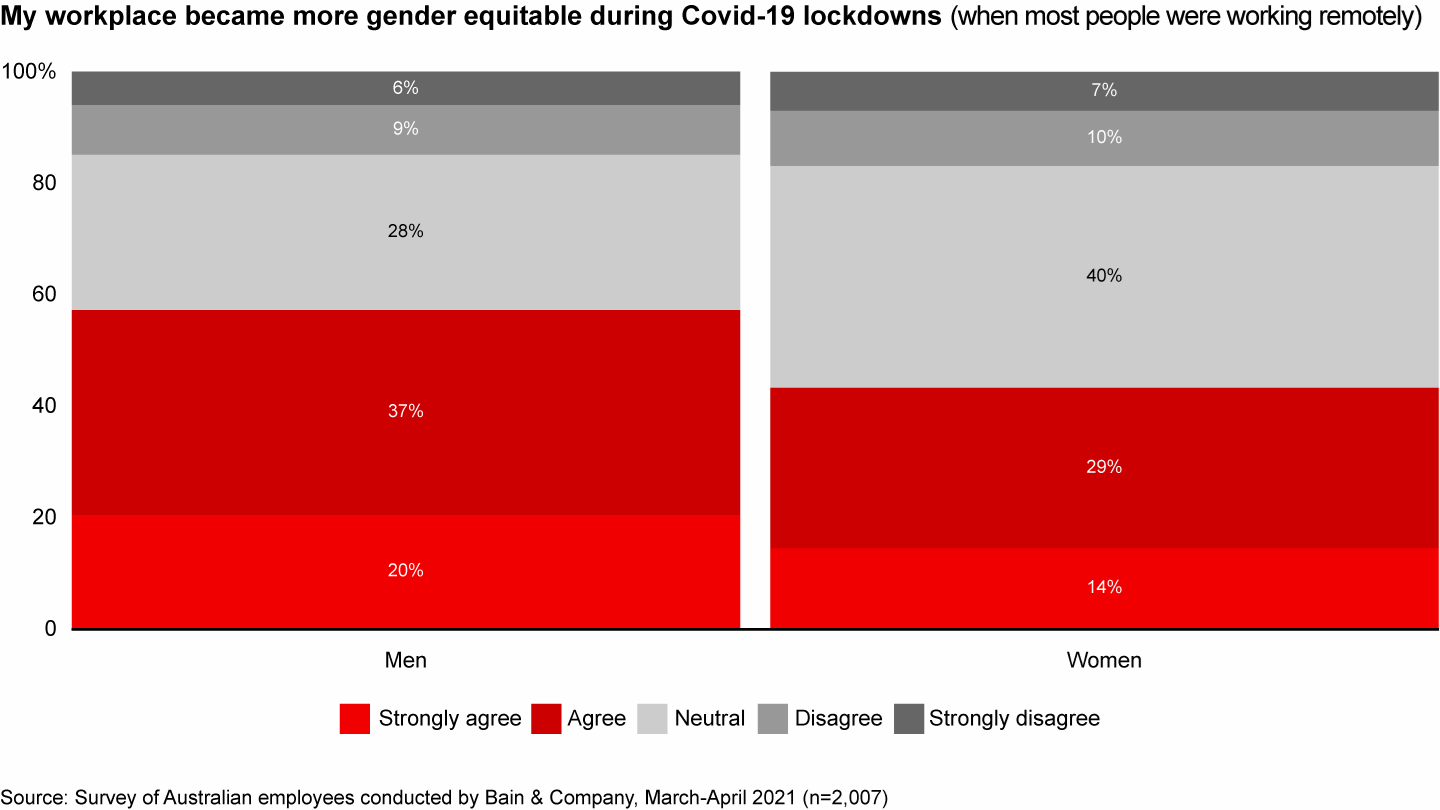

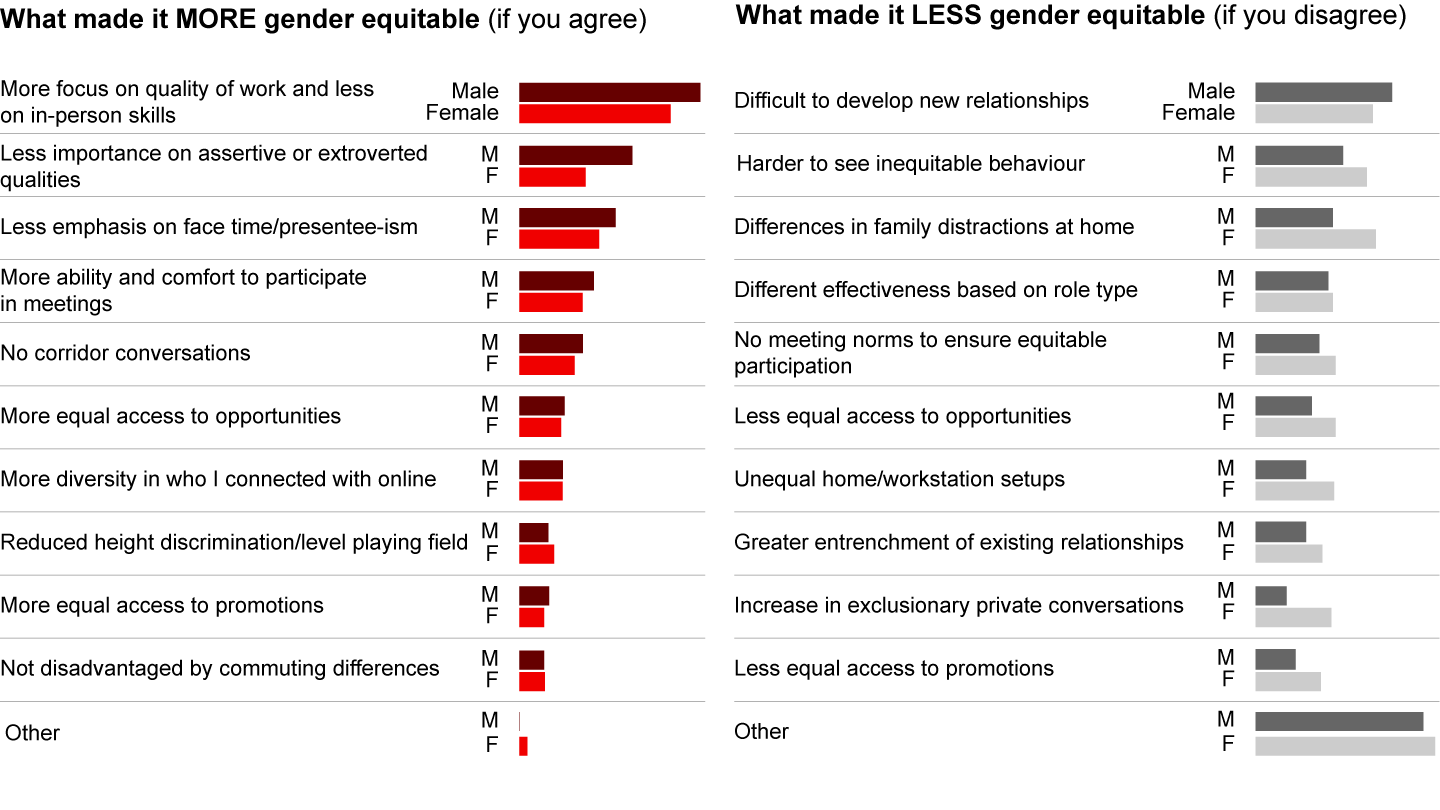
Building trust levels the playing field for all employees, and lessens the pressure to ‘always be in the room’ to earn a promotion or desirable work assignments.
Set flexibility performance criteria
- Companies measure what matters. To encourage inclusive behaviours and management skills, businesses can establish flexibility as a key performance metric.
- One suggestion is to create a flex ‘scorecard’ as part of company performance criteria and reviews, which measures how actively employees use or encourage flexible work mechanisms.
- For executives and managers, compensation and bonuses could be tied to flexibility to drive accountability and incentivise adoption.
Question #3: Do we provide employees with the right technology and training?
Employees need the right technology, tools, and training to facilitate effective flexible work. Without the right infrastructure, flexible workers could face disadvantages, or flexible arrangements could create adverse consequences.
Invest in technology
Work location should not deter performance or productivity. Team-wide and company-wide, collaboration technology should be embedded into workflows, so hybrid and blended teams are equipped to work effectively.
Some companies are building allowances into their budgets to ensure remote workers do not suffer disadvantages due to equipment or their home-office setups (e.g., technology upgrades, ergonomic improvements, internet, or electricity reimbursements).
During the pandemic, IAG gave its people a A$400 ergonomic reimbursement and a yearlong A$40 monthly utility reimbursement. The company wanted to ensure its employees had equal and financial support to work remotely, regardless of their domestic setup. It also signalled that IAG understood what people were going through and symbolised its commitment to help.
Technology upgrades and process digitisation can remove some nine-to-five restrictions that prevent some employees from working flexibly. When administrative processes are not confined to ‘traditional’ work hours, companies can achieve productivity gains and enable greater efficiencies.
To support a compressed work-week experiment at Unilever in New Zealand, the organisation reviewed and adapted its working practices, a key one being the digitisation of back-end processes (which was enhanced by the adoption of Agile). This allowed employees to focus more time on high-value work rather than menial tasks, and to structure their working day more effectively in order to boost productivity. Additionally, employees at Unilever were taught how to eliminate digital and environmental distractions; how to get deep, focused work done; and how to form new rituals to drive productivity and wellbeing.
Train staff and managers
To ensure effective flexibility, employees should be trained on best practices and team norms. ANZ found that the majority of its flexibility challenges need to be resolved at the team level, so team leaders and supervisors are trained on how to manage flexible teams. Their employees said training gave them more confidence to lead flexible teams and to handle challenging or uncomfortable conversations.
Flexible work changes the team dynamic and may require managers to communicate or assign work differently. Supervisors need training on how to manage, lead, and support flexible workers.
As such, Newmont invested strongly in its training programs. Training on Newmont Corporate Values (including Inclusion) is conducted annually, and the company has numerous training modules on equitable flex (in remote working conditions). Topics include how to recognise performance in those who aren’t as vocal; how to have a difficult conversation with an employee around flex; training against common and unconscious biases; and balance, including how to turn off/say no. Newmont compiles and shares lessons learned from employees, and leverages best practices that new hires bring from other industries. Newmont said the biggest factor in promoting equitable flex is following up to test employees’ understanding of the training to ensure they comprehend and implement what they learn.
Question #4: Do we ensure employees have equal access for roles and opportunities?
To encourage flexible work, companies need to ensure employees will not be disadvantaged by non-traditional work arrangements. Flexible employees should be appropriately considered for promotions, assignments, and leadership opportunities.
Assess roles and remove biases
Flexible workers often have decisions made for them, particularly around opportunities they can or cannot accept, and they are not considered for assignments that could influence their career progression. Similarly, flexible workers are often assigned discrete or individual projects rather than being asked to lead or work in larger teams.
Each position will have different flexibility potential, and trade-offs may exist. Consider personal characteristics that each role requires, as well as daily job tasks, duties, responsibilities, and connections. Understand which constraints are real (versus perceived) to ensure flexible workers receive appropriate consideration for opportunities.
One suggestion is to create prompt cards for supervisors that outline common assumptions or biases, and mitigants to recommend. For example, if a position is based in Melbourne, determine exactly how often the employee needs to be on site. If it is only three days a month, then an employee who lives outside Melbourne could be a viable candidate.
At Stockland, when one senior employee was considering a role, he specified a desire to work 8-9 months of the year. When the team assessed the job requirements, it was determined that the role could be done through a custom arrangement that met the desired 8-9 month timeframe with little disruption. It worked—for the employee and the business. A concerted effort to understand and define the exact conditions of the role made the arrangement possible.
Be transparent about promotions
Communication is an important component of transparency, especially when allocating opportunities to employees. Ensure all employees learn about potential opportunities at the same time and through common processes (e.g., an online job board), regardless of their work location or hours.
Of course, not every position has equal flexibility potential. When flexible working arrangements could affect a career path or promotion potential, the organisation has a responsibility to be transparent and clear about any limitations.
In this area, best practices are to:
- Discuss limitations at key decision-making points and before flexible arrangements are made. Employees need clear, consistent, and transparent guidelines on how flexible options may affect one’s career.
- Track how promotions, bonuses, and performance scores compare between flexible and traditional workers. This helps companies identify biases and become more intentional and inclusive as they manage talent.
- Adopt a ‘why not?’ vs. ‘why?’ approach to promotion considerations. Managers must articulate why a candidate cannot perform the duties of the job, irrespective of work location or other flexible arrangements.
Gilbert + Tobin’s promotion criteria is explicit: Promotions are based on ability, not on tenure, and employees who don’t meet established performance criteria may not be promoted. The HR team regularly reviews employees who are in promotion windows based on tenure or post-qualification to understand why people advance differently. If an employee isn’t promoted or isn’t recommended for promotion, they ask why so they can ensure a fair promotion process.
Question #5: Are leaders actively and authentically role-modelling flexibility?
By embracing flexibility, male executives can increase equity in the workplace. Leaders can also support workers and teams while they iterate over flexible work arrangements.
Role-model flex at the executive level
Executive role-modelling is one of the most effective ways to normalise flexibility. It gives leaders greater perspective on how flexible employees work (both the challenges and the advantages) and encourages more people to partake in flexible arrangements.
Executive-level adoption also encourages men to participate in flexible work arrangements, which is critical. According to the Workplace Gender Equality Agency (WGEA), 70% of workplaces have a flexible work policy in place, yet only 2% have targets for men’s engagement in flexible work.
Mirvac found a chance to challenge its thinking on flexibility in 2014, when it was approached by WGEA to participate in ‘Equilibrium Man’, a docuseries that followed several men on their flexibility journeys. Mirvac had two employees participate. The project helped normalise discussions about flexibility and encouraged dialogue in an informal, relaxed manner. During the series, male participants reported being more supportive of flexible workers.
Both men and women agree that men taking up flexibility initiatives is critical to making flexibility less detrimental to those who take it. Nearly 70% of respondents (and 70% of men) said men’s participation is critical to reduce stigma around flexibility and encourage participation (see Figure 5).
Employees believe flexibility initiatives will be less disadvantageous if more men adopt them

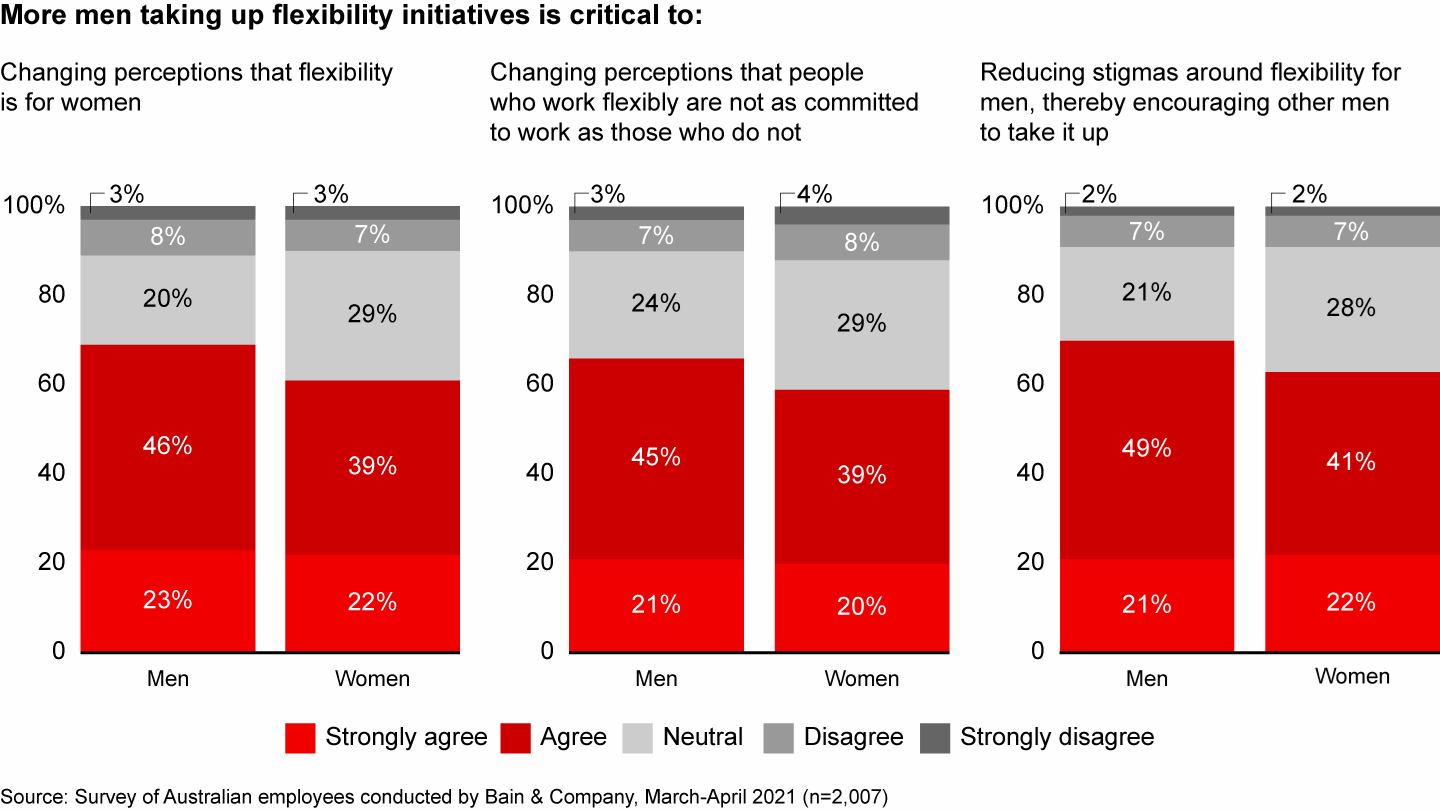
Leading by example is effective, even when the actions are small. Simply ‘leading loudly’ and talking about flexibility normalises adoption. Executive teams can also model the way by using virtual meetings more than travel.
At Stockland, some managers who worked solely in the office before Covid-19 are now choosing to work from home so they can have lunch with their families. Sharing those stories openly and regularly with their teams helps normalise such arrangements and positions them as a desirable benefit.
Use inclusive and supportive language
Language matters, too. Leaders can role-model this by choosing deliberate and thoughtful messaging about flexibility.
Social Ventures Australia (SVA) has embraced different forms of flexibility for a long time and has open conversations with employees about how flexibility works for various roles. For example, working from home on a regular basis may be suitable for many accounting tasks, whilst relationship-focused efforts like fundraising require more regular face-to-face conversations. When appropriate, SVA makes flexibility standards inclusive. For example, it offers a gender-neutral parental leave policy and carefully words its policies to be inclusive.
Attitude is the final piece of the puzzle. To figure out what works, leaders must encourage employees to act quickly, take smart risks, and learn from mistakes. They must also support people and teams as mistakes and miscommunication occurs—without dismissing them as reasons why flexible arrangements cannot work. Teams will need to iterate to develop their most effective flexible working models.
Unilever is comfortable innovating and experimenting with flexibility models. It is currently trialling a four-day workweek across its entire New Zealand office. The experiment is slated to run for 12 months, with the potential to extend the arrangement if it’s successful. Leaders are describing the experiment as ‘100% pay, 80% hours, 100% productivity,’ with promising initial results.
Conclusion
Workplace flexibility isn’t a unique perk—it’s a new business imperative. To revitalise and strengthen the Australian economy, we need to leverage all of the nation’s talent. Equitable flexibility will be one of the keys that unlocks our resilience and our potential.
When companies weigh the advantages of equitable flexibility, going back to ‘business as usual’ after the pandemic is not an option. The challenge then, is how to enable the most effective and equitable flexibility practices.
While it may sound ironic, instituting widespread flexibility requires discipline. To affect meaningful change—in performance, culture, and equity—companies need to be purposeful and thorough in how they design flexibility. Equitable flexibility touches every facet of the company. From top to bottom, companies will need to adjust workflows and business processes, cultural norms, technology, and tools.
Because of Covid-19, most companies have already begun their flexibility journey. Covid-19 accelerated flexible work imperatives and presented a unique ‘trial opportunity.’ Companies adapted their business models out of necesssity and learned by doing. So far, it’s working.
Our five questions for leaders offer structure and best practices as the flexibility journey continues. From here, companies can redesign work practices to focus more tightly on efficacy and performance, and by doing so, advance gender equality faster than previously foreseeable.
This new, widely accepted mindset is important fuel for advancing gender equality in the workplace. Post-Covid-19, flexibility is not viewed as a ‘women’s issue’ or a sign of apathy; it is simply how business and life get done.
Equitable flexibility organisational assessment tool
How equitable is the flexibility at your organisation? The tool presented below can be used with your executive leadership team to identify areas of development and focus future efforts there.
This is the second in a set of tools developed by CEW and Bain & Company on flexibility. In our previous report, ‘Flex for Success: Five Practices That Build a Flexible Workforce’, the first tool can help your organisation understand where it is on its journey to flexibility. The second tool builds on that, and can be used to ensure that the flexibility your organisation is offering is equitable.

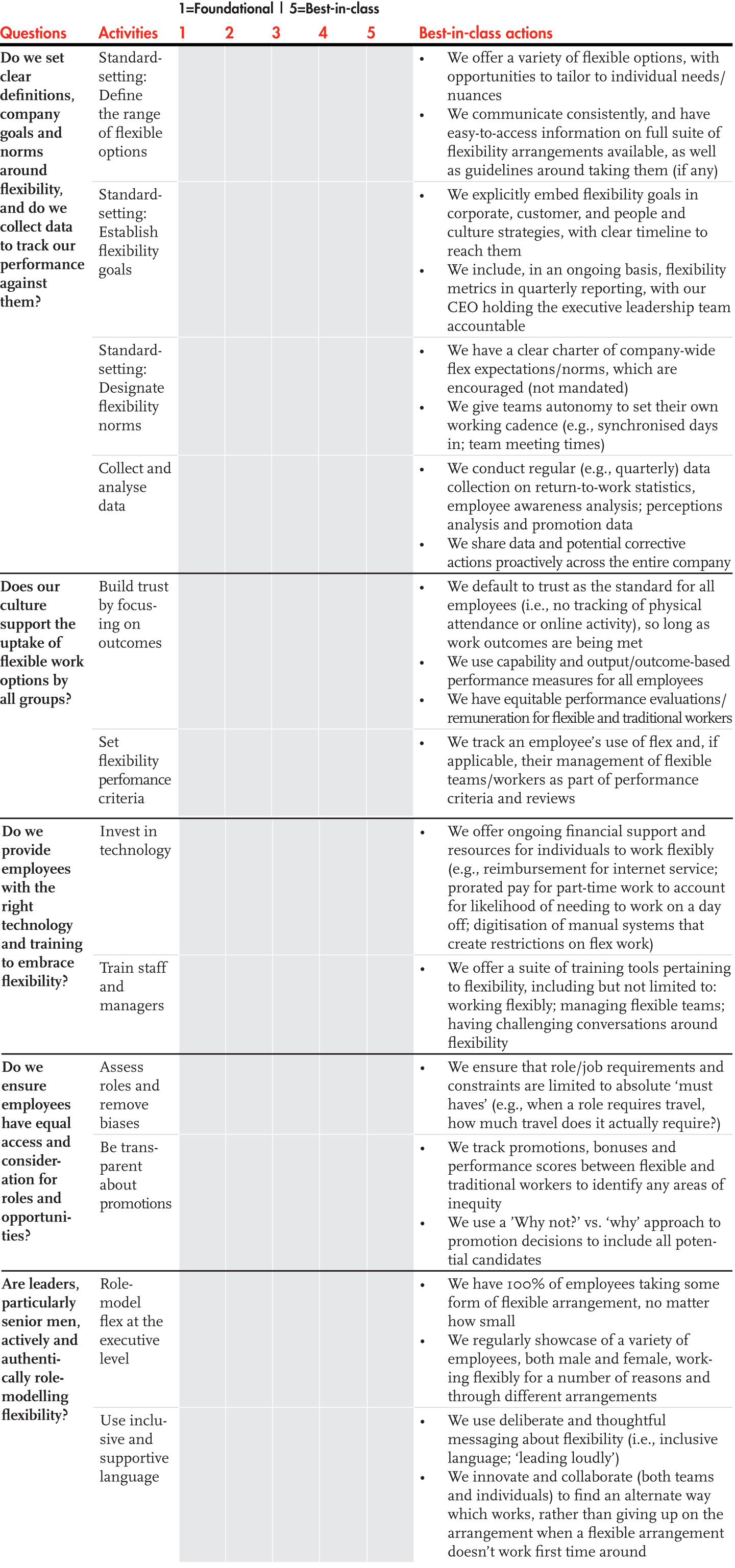

About Chief Executive Women
Chief Executive Women’s (CEW’s) almost 1,000 members hold leading roles in Australia’s largest private and public organisations. They oversee more than 1.3 million employees and $749 billion in revenue. Members’ organisations have a combined market capitalisation greater than $1.144 trillion and contribute in excess of $249 billion to Australia’s GDP. Since 1985, CEW has influenced and engaged all levels of Australian business and government to achieve gender balance. Through advocacy, research, targeted programmes, and scholarships, CEW helps remove barriers to women’s progression and ensures equal opportunity for prosperity. CEW’s members work actively to realise our vision of a community where women and men have equal economic and social choices and responsibilities.

This report was supported by ANZ, thought leadership partner of Chief Executive Women.